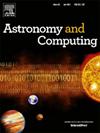Impact of cosmic web on galaxy properties and their correlations: Insights from Principal Component Analysis
IF 1.8
4区 物理与天体物理
Q2 ASTRONOMY & ASTROPHYSICS
引用次数: 0
Abstract
We use Principal Component Analysis (PCA) to analyse a volume-limited sample from the SDSS and explore how cosmic web environments affect the interrelations between various galaxy properties, such as colour, stellar mass, specific star formation rate, metallicity, morphology, and . Our analysis reveals that the first three principal components (PC1, PC2 and PC3) account for approximately of the data variance. We classify galaxies into different cosmic web environments based on the eigenvalues of the deformation tensor and compare PC1, PC2, PC3 across these environments, ensuring a mass-matched sample of equal size for each environment. PC1 is dominated by colour, sSFR, D4000, and morphology. It displays clear bimodality across all cosmic web environments, with sheets and clusters showing distinct preferences for negative and positive PC1 values, respectively. This variation reflects the strong role of environmental processes in regulating star formation. PC2 and PC3, respectively show positively and negatively skewed unimodal distributions in all environments. PC2 is primarily influenced by metallicity whereas PC3 is dominated by stellar mass. It indicates that metallicity evolves gradually and is less sensitive to environmental extremes, highlighting the importance of internal, secular processes. PC3 likely captures residual variation in stellar mass within the two main galaxy populations (star-forming and quiescent) separated by PC1. A Kolmogorov–Smirnov (KS) test confirms that the distributions of PC1, PC2 and PC3 differ significantly across environments, with a confidence level exceeding 99.99%. Furthermore, we calculate the normalized mutual information (NMI) between the principal components and individual galaxy properties within different cosmic web environments. A two-tailed t-test reveals that for each relationship and each pair of environments, the null hypothesis is rejected with a confidence level . Our analysis confirms that cosmic web environments play a significant role in shaping the correlations between galaxy properties.
宇宙网对星系特性的影响及其相关性:来自主成分分析的见解
我们使用主成分分析(PCA)来分析来自SDSS的体积有限的样本,并探索宇宙网环境如何影响各种星系特性之间的相互关系,如(u−r)颜色、恒星质量、特定恒星形成率、金属丰度、形态和D4000。我们的分析表明,前三个主成分(PC1、PC2和PC3)约占数据方差的85%。我们根据变形张量的特征值将星系划分为不同的宇宙网环境,并在这些环境中比较PC1, PC2, PC3,确保每个环境的质量匹配样本大小相等。PC1主要由颜色、sSFR、D4000和形态决定。它在所有宇宙网环境中都显示出明显的双峰性,薄片和星团分别显示出对负和正PC1值的明显偏好。这种变化反映了环境过程在调节恒星形成中的重要作用。PC2和PC3在所有环境下分别呈正、负偏态单峰分布。PC2主要受金属丰度的影响,而PC3主要受恒星质量的影响。这表明金属丰度是逐渐演变的,对极端环境不太敏感,突出了内部长期过程的重要性。PC3可能捕获了被PC1隔开的两个主要星系群(恒星形成和静止)中恒星质量的残余变化。Kolmogorov-Smirnov (KS)检验证实PC1、PC2和PC3的分布在不同环境下存在显著差异,置信水平超过99.99%。此外,我们计算了不同宇宙网环境下主成分与单个星系属性之间的归一化互信息(NMI)。双尾t检验显示,对于每个关系和每对环境,原假设被拒绝,置信度为99.99%。我们的分析证实,宇宙网络环境在形成星系属性之间的相关性方面发挥着重要作用。
本文章由计算机程序翻译,如有差异,请以英文原文为准。
求助全文
约1分钟内获得全文
求助全文
来源期刊

Astronomy and Computing
ASTRONOMY & ASTROPHYSICSCOMPUTER SCIENCE,-COMPUTER SCIENCE, INTERDISCIPLINARY APPLICATIONS
CiteScore
4.10
自引率
8.00%
发文量
67
期刊介绍:
Astronomy and Computing is a peer-reviewed journal that focuses on the broad area between astronomy, computer science and information technology. The journal aims to publish the work of scientists and (software) engineers in all aspects of astronomical computing, including the collection, analysis, reduction, visualisation, preservation and dissemination of data, and the development of astronomical software and simulations. The journal covers applications for academic computer science techniques to astronomy, as well as novel applications of information technologies within astronomy.
 求助内容:
求助内容: 应助结果提醒方式:
应助结果提醒方式:


